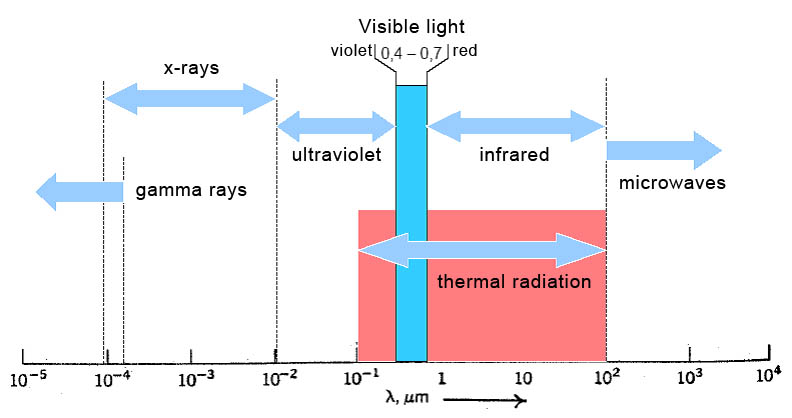Basics of heat and infrared radiation
Heat radiation is electromagnetic waves that can transmit heat without transport medium. According to Planck's law of radiation, every body whose temperature is above the absolute zero of the temperature emits heat radiation. The spectrum of this radiation depends on the temperature and the physical and chemical character of the surface.

Starting from the idealized model of the blackbody, the spectrum of the emitted radiation can be described using Planck's law of radiation. A black body is characterized by the fact that the radiation which is impinging on it is completely absorbed. Real spotlights more or less deviate from this ideal picture. The absorption coefficient α and the emissivity ε are used for their description.
Thus an emitter is effective for its emitting wavelength range if it has the highest possible emissivity for this area.
Figure 2 shows the spectral radiating power of the black body for some temperatures. All curves have a maximum, which is shifted with increasing temperature in the direction of decreasing wavelength. [www.etp.uni-hannover.de]

Heater types
Emission and absorption correspond to the generation or destruction of radiation quanta, which means an interaction with matter. Atoms emit or absorb only quanta of well-defined energy. The energy difference of the state in the atom before and after the emission or absorption corresponds exactly to the energy of the quantum.
The conditions within the atom are also quantized. Certain wavelengths are created by certain excitation levels of the atoms. The same atoms have the same excitation levels and therefore emit or absorb exactly the same under the assumption.
Classification of infrared radiation
Radiation is generally differentiated by wavelength (e. g.: gamma radiation <x-ray <ultraviolet radiation (short: UV) <infrared radiation (short: IR) <microwave radiation). In many thermal processes IR emitters are used. These are classified according to DIN 5031 into different spectral ranges:
|
Description |
Short sign |
wavelengthin μm |
Temperature according to Wien |
Parlance |
|
near infrared |
NIR |
0.78...1.4 |
over 1600 K |
short waved infrared |
|
medium infrared |
MIR |
1.4...3.0 |
1600 – 800 K |
middle waved infrared |
|
far infrared |
FIR |
3...50 |
800 - 3 K |
long waved infrared |
Depending on the requirements of the process and the product, the appropriate infrared radiator must be selected. With its portfolio, IBT covers all types of infrared radiators. More information can be found here.